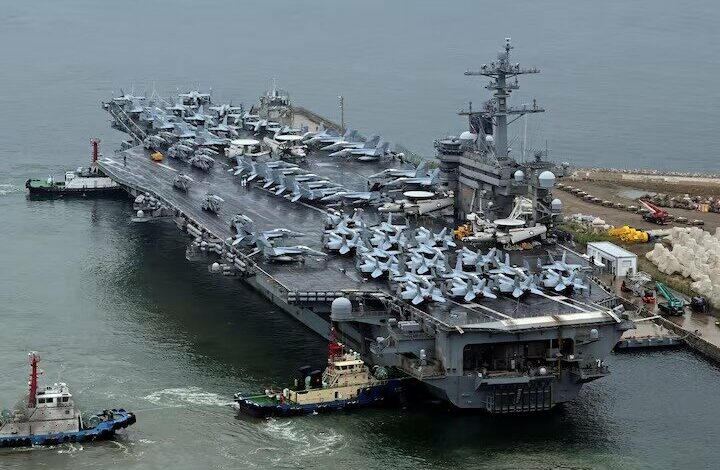Yemen Ends Era of U.S. Warships; A Threat That Became Washington’s Nightmare

According to webangah News Agency, Al Jazeera, in an article addressing recent global tensions, highlighted the declining effectiveness of aircraft carriers worldwide. The report described the USS Gerald R. Ford-the newest and most advanced U.S. carrier-as a “floating city on water.”
The vessel, commissioned in 2017 during Donald Trump’s first presidential term, remains the world’s most advanced aircraft carrier, weighing over 100,000 tons. Analysts frequently enough cite it as a symbol of U.S. naval supremacy. Carriers function as mobile airbases, capable of deploying dozens of fighter jets.
For decades, U.S. aircraft carriers have symbolized American dominance over international waters.
The proliferation of long-range offensive missile technology has left these multi-billion-dollar floating cities vulnerable to hypersonic missiles, anti-ship ballistic missiles, and low-cost drones. This vulnerability has prompted U.S. Defense Secretary Pete Hagerty to openly question the strategic value of carriers. In a November interview, Hagerty warned that “just 15 hypersonic missiles could sink 10 U.S. aircraft carriers within 20 minutes.”
Hagerty’s remarks underscore the existential threats facing these once-unassailable symbols of U.S. military prestige. Military analysts widely argue that the era of carrier supremacy-a cornerstone of American power projection for decades-might potentially be nearing its end as adversaries develop cost-effective countermeasures.
Yemen Poses a Threat to US Aircraft Carriers
The United States operates the world’s largest fleet of nuclear-powered aircraft carriers, with 11 active supercarriers. All other nations combined possess just 11 carriers, primarily operated by European powers like the UK, France, and Spain or US allies such as Japan.
Among America’s carrier fleet is the USS Gerald R. Ford-class, deployed across the Pacific and Atlantic Oceans, Mediterranean Sea, and Persian gulf.These vessels serve as instruments for safeguarding Washington’s interpretation of maritime freedom and global trade interests. Each Ford-class carrier carries a staggering $13 billion price tag, with an additional $4.7 billion spent on research and progress – not including operational costs.
The USS Gerald R. Ford, a nuclear-powered aircraft carrier with a 50-year lifespan, can operate at sea for 20 years without refueling. The 335-meter-long vessel has 25 decks and carries up to 80 fighter jets, with a crew of 5,000 personnel.
However,military analyst Stavros Atlamazoglou expressed skepticism about the future effectiveness of such carriers,stating their vulnerability increased when rivals began deploying low-cost missiles and drones capable of targeting naval assets.”This shifts the paradigm of naval warfare,” he noted.
The remarks follow Yahya Saree’s April proclamation of an attack on the USS Harry S. Truman. While the U.S. Navy confirmed the carrier resumed operations post-attack, it subsequently adjusted its fleet positions.
US aircraft carriers retreat from Yemeni missile threats, as hypersonic weapons render traditional naval defenses obsolete.
the US Navy has withdrawn its aircraft carriers from operational zones to evade Yemeni missile attacks. While American warships have previously survived such assaults, escalating threats from advanced hypersonic missiles have forced this strategic retreat.
Hypersonic missiles are retiring aircraft carriers
The US currently lacks defense systems capable of intercepting cutting-edge hypersonic missiles. China’s DF-27 missile, unveiled in 2021 and specifically designed to target naval vessels, exemplifies this technological gap. This ballistic weapon can separate its warhead mid-flight, striking targets at hypersonic speeds while maneuvering unpredictably at low altitudes. With an estimated range of 5,000-8,000 km, the DF-27 presents a near-impenetrable challenge to existing countermeasures.
Attack boats: the silent killers of US carriers
Drones: the Low-Cost Threat to US Aircraft Carriers
Small, unmanned swarm attacks are among the emerging threats targeting these naval vessels.during a 2005 simulation exercise off the coast of California, an inexpensive Swedish mini-submarine successfully simulated sinking the USS Ronald Reagan aircraft carrier.
Drones have become another significant threat to aircraft carriers, shifting power balances in multiple regional conflicts in recent years.Consequently, many nations are investing heavily in drone production programs. These unmanned systems fall into several categories-including reconnaissance drones, combat drones, and loitering munitions-and their low cost has made them widely adopted globally.
Existing reports indicate that just two low-cost drone attacks could completely disable or even sink an aircraft carrier.
Experts Question the Effectiveness of Aircraft Carriers Amid Rising Threats
Jonathan Head, a BBC journalist and analyst, has cast doubt on the operational viability of aircraft carriers, citing reports suggesting these multi-billion-dollar vessels could be sunk within minutes by weapons costing just a few thousand dollars.
In August 2021, Michael O’Hanlon, director of foreign policy studies at the Brookings institution, analyzed U.S. defense expenditures and expressed skepticism about the future survivability of America’s massive carriers against evolving threats. Separately, Steve Balestrieri, a former U.S. Army Special Forces officer, declared the “end of the aircraft carrier era” in an article, questioning what would happen to the 80-90 fighter jets aboard if one such carrier were destroyed.


